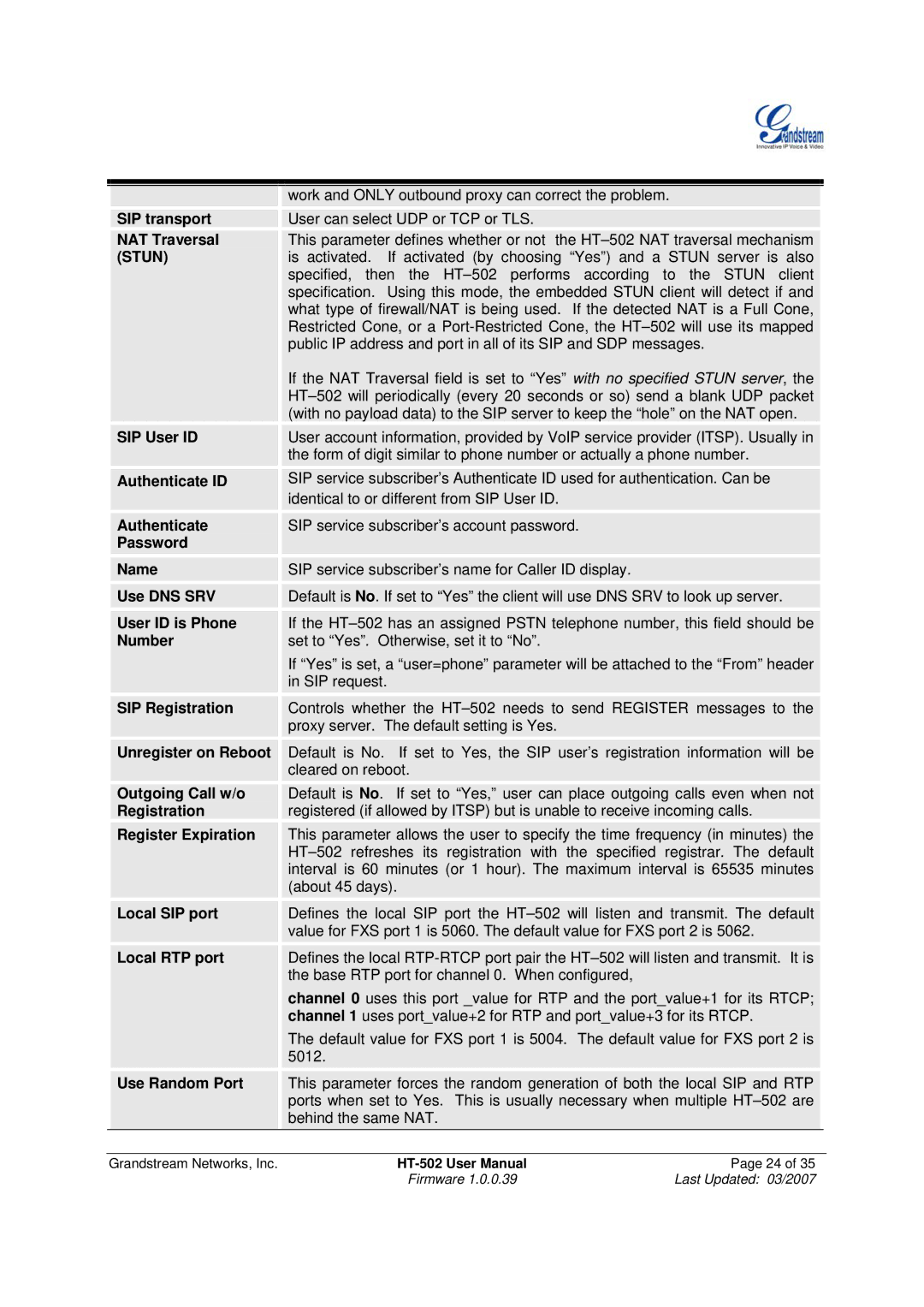
SIP transport
NAT Traversal (STUN)
SIP User ID
Authenticate ID
work and ONLY outbound proxy can correct the problem.
User can select UDP or TCP or TLS.
This parameter defines whether or not the
If the NAT Traversal field is set to “Yes” with no specified STUN server, the
User account information, provided by VoIP service provider (ITSP). Usually in the form of digit similar to phone number or actually a phone number.
SIP service subscriber’s Authenticate ID used for authentication. Can be identical to or different from SIP User ID.
| Authenticate |
| SIP service subscriber’s account password. |
|
|
| |
| Password |
|
|
|
|
|
|
|
|
|
|
|
|
| |
| Name |
| SIP service subscriber’s name for Caller ID display. |
|
|
| |
|
|
|
|
| |||
| Use DNS SRV |
| Default is No. If set to “Yes” the client will use DNS SRV to look up server. |
|
| ||
|
|
|
|
| |||
| User ID is Phone |
| If the |
|
| ||
| Number |
| set to “Yes”. Otherwise, set it to “No”. |
|
|
| |
|
|
| If “Yes” is set, a “user=phone” parameter will be attached to the “From” header |
|
| ||
|
|
| in SIP request. |
|
|
|
|
|
|
|
|
| |||
| SIP Registration |
| Controls whether the |
|
| ||
|
|
| proxy server. The default setting is Yes. |
|
|
| |
|
|
|
|
|
| ||
| Unregister on Reboot |
| Default is No. | If set to Yes, the SIP user’s registration information will be |
|
| |
|
|
| cleared on reboot. |
|
|
| |
|
|
|
|
|
|
| |
| Outgoing Call w/o |
| Default is No. | If set to “Yes,” user can place outgoing calls even when not | |||
| Registration |
| registered (if allowed by ITSP) but is unable to receive incoming calls. |
|
| ||
|
|
|
|
| |||
| Register Expiration |
| This parameter allows the user to specify the time frequency (in minutes) the |
|
| ||
|
|
|
|
| |||
|
|
| interval is 60 minutes (or 1 hour). The maximum interval is 65535 minutes |
|
| ||
|
|
| (about 45 days). |
|
|
| |
|
|
|
|
| |||
| Local SIP port |
| Defines the local SIP port the |
|
| ||
|
|
| value for FXS port 1 is 5060. The default value for FXS port 2 is 5062. |
|
| ||
|
|
|
|
| |||
| Local RTP port |
| Defines the local |
|
| ||
|
|
| the base RTP port for channel 0. When configured, |
|
|
| |
|
|
| channel 0 uses this port _value for RTP and the port_value+1 for its RTCP; |
|
| ||
|
|
| channel 1 uses port_value+2 for RTP and port_value+3 for its RTCP. |
|
| ||
|
|
| The default value for FXS port 1 is 5004. The default value for FXS port 2 is |
|
| ||
|
|
| 5012. |
|
|
|
|
|
|
|
|
| |||
| Use Random Port |
| This parameter forces the random generation of both the local SIP and RTP |
|
| ||
|
|
| ports when set to Yes. This is usually necessary when multiple |
|
| ||
|
|
| behind the same NAT. |
|
|
| |
|
|
|
|
|
|
|
|
Grandstream Networks, Inc. |
|
| Page 24 of 35 | ||||
|
|
|
| Firmware 1.0.0.39 | Last Updated: 03/2007 | ||
